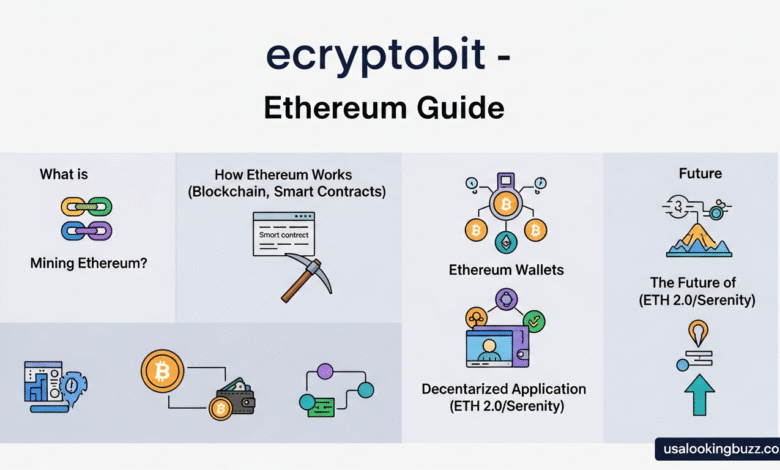Ecryptobit.com Ethereum: Complete Trading Guide

Introduction
You’re watching Ethereum’s price fluctuate wildly, wondering if now’s the right time to invest. The crypto market moves fast, and finding a reliable platform that helps you make smart decisions feels overwhelming. You’ve heard about ecryptobit.com ethereum services, but you’re not sure if it’s the right choice for your trading needs.
Ethereum has grown from a experimental blockchain project to the second largest cryptocurrency by market cap. It powers thousands of decentralized applications and has revolutionized how we think about digital finance. But trading Ethereum successfully requires more than just buying low and selling high.
That’s where platforms like ecryptobit.com ethereum come into play. These services promise to simplify crypto trading while providing tools that help you make informed decisions. But do they deliver on those promises? And more importantly, can they help you achieve your investment goals?
This comprehensive guide explores everything you need to know about ecryptobit.com ethereum trading. You’ll discover how the platform works, what features it offers, trading strategies that actually work, and how to protect yourself from common pitfalls. Whether you’re new to crypto or an experienced trader, this article provides valuable insights for your journey.
Understanding Ethereum and Why It Matters
What Makes Ethereum Special
Ethereum represents much more than just another cryptocurrency. While Bitcoin focuses primarily on peer to peer payments, Ethereum created an entire ecosystem for decentralized applications. The blockchain serves as a global computer that runs programs called smart contracts.
Smart contracts execute automatically when specific conditions are met. They eliminate middlemen and create trustless transactions. You don’t need lawyers, banks, or other intermediaries. The code enforces agreements automatically, making processes faster and cheaper.
Ethereum introduced the concept of programmable money. Developers can build applications that handle financial transactions, create digital assets, or manage complex agreements. This flexibility has made Ethereum the foundation for decentralized finance, NFTs, and countless other innovations.
The Ethereum network processes over one million transactions daily. Thousands of developers continuously improve the ecosystem. Major corporations and financial institutions are building on Ethereum. This widespread adoption suggests Ethereum will remain relevant for years to come.
Ethereum’s Evolution and Upgrades
Ethereum has undergone significant changes since its 2015 launch. The most important transformation was the move from proof of work to proof of stake consensus. This upgrade, called The Merge, reduced Ethereum’s energy consumption by 99.95%.
Proof of stake makes the network more secure and sustainable. Validators stake their ETH to secure the network rather than using massive amounts of electricity. This change addresses environmental concerns that plagued earlier blockchain systems.
Scalability improvements continue rolling out through various upgrades. Layer 2 solutions like Optimism and Arbitrum process transactions off the main chain, then settle on Ethereum. These solutions dramatically reduce fees and increase transaction speed.
The roadmap includes further improvements that will make Ethereum faster, cheaper, and more accessible. These ongoing developments strengthen Ethereum’s position as the leading smart contract platform. Understanding this evolution helps you appreciate why platforms like ecryptobit.com ethereum focus on this particular cryptocurrency.
What Is Ecryptobit.com Ethereum Platform
Platform Overview and Features
Ecryptobit.com ethereum is a cryptocurrency trading platform specializing in Ethereum trading and related services. The platform aims to provide both beginners and experienced traders with tools for buying, selling, and managing ETH investments.
Trading platforms in the crypto space serve as intermediaries between you and the blockchain. They provide user friendly interfaces, market data, and trading tools that make cryptocurrency accessible. Ecryptobit.com positions itself as a comprehensive solution for Ethereum enthusiasts.
The platform typically offers real time price tracking, trading charts, and market analysis tools. These features help you make informed decisions based on current market conditions. Access to accurate, timely information is crucial in the volatile crypto market.
Security features form another important aspect of any trading platform. Cryptocurrency exchanges and trading services must protect user funds from hackers and unauthorized access. Understanding what security measures ecryptobit.com ethereum implements helps you assess the platform’s reliability.
How the Platform Works
Using ecryptobit.com ethereum typically involves creating an account and completing verification procedures. Know Your Customer (KYC) requirements have become standard in the crypto industry. These procedures help platforms comply with financial regulations.
Once verified, you can deposit funds to start trading. Most platforms accept bank transfers, credit cards, or cryptocurrency deposits. The funding method you choose affects how quickly you can start trading and what fees you’ll pay.
The trading interface allows you to place various order types. Market orders execute immediately at current prices. Limit orders let you specify the price you’re willing to pay. Stop loss orders automatically sell if prices drop to predetermined levels.
Withdrawing funds typically requires additional verification for security purposes. You’ll need to provide wallet addresses and confirm transactions. Understanding the withdrawal process before you need it prevents frustration during urgent situations.
Getting Started with Ethereum Trading
Setting Up Your Trading Account
Starting with ecryptobit.com ethereum begins with registration. You’ll provide basic information like email, name, and contact details. Choose a strong, unique password that you don’t use anywhere else. Password managers help you create and store complex passwords securely.
Verification processes vary by platform and jurisdiction. You may need to provide government issued identification, proof of address, and sometimes additional documentation. While verification feels tedious, it protects both you and the platform from fraud.
Two factor authentication (2FA) adds crucial security to your account. This requires a second verification method beyond your password. Authenticator apps like Google Authenticator or Authy provide better security than SMS based 2FA.
Familiarize yourself with the platform interface before depositing significant funds. Most platforms offer demo accounts or paper trading features. Practicing with pretend money helps you understand how everything works without risking real capital.
Funding Your Account Safely
Depositing funds requires careful attention to security. Always verify you’re on the legitimate ecryptobit.com ethereum website. Phishing sites mimic real platforms to steal your credentials and money. Bookmark the official site and only access it from your bookmark.
Start with smaller deposits until you’re comfortable with the platform. This limits potential losses if something goes wrong. You can always deposit more once you’ve verified everything works smoothly.
Different funding methods have different fees and processing times. Bank transfers often have lower fees but take days to process. Credit cards provide instant funding but charge higher fees. Cryptocurrency deposits from other wallets offer a middle ground.
Keep records of all your deposits and transactions. Screenshots, confirmation emails, and transaction IDs help you track everything. This documentation becomes crucial for tax reporting and resolving any disputes.
Understanding Market Basics
Ethereum’s price changes constantly based on supply and demand. Multiple factors influence these movements including technology updates, regulatory news, market sentiment, and macroeconomic conditions. No single factor determines price alone.
Market volatility in cryptocurrency exceeds traditional assets significantly. Ethereum can gain or lose 10% or more in a single day. This volatility creates opportunities for profit but also substantial risk. Never invest money you can’t afford to lose.
Trading pairs show the relationship between two assets. ETH/USD pairs show Ethereum’s price in US dollars. ETH/BTC pairs show how much Bitcoin one Ethereum costs. Understanding pairs helps you interpret price movements correctly.
Market capitalization represents Ethereum’s total value. Multiply the current price by the circulating supply. Market cap helps you compare Ethereum to other cryptocurrencies and understand its relative size in the crypto ecosystem.
Essential Trading Strategies
Long Term Holding Strategy
Long term holding, or “HODLing” in crypto terminology, means buying Ethereum and holding regardless of short term price movements. This strategy suits people who believe in Ethereum’s long term potential but don’t want to actively trade.
The advantage of holding is simplicity. You don’t need to monitor prices constantly or make frequent trading decisions. You also avoid transaction fees from repeated buying and selling. Tax implications often favor long term holdings too.
Dollar cost averaging pairs perfectly with long term holding. You invest fixed amounts at regular intervals regardless of price. This strategy reduces the impact of volatility. You automatically buy more when prices are low and less when prices are high.
Patience is crucial for successful holding strategies. Ethereum has experienced multiple 50% or greater drawdowns in its history. Long term holders who stayed the course through these dips have generally been rewarded. But this requires strong conviction and risk tolerance.
Active Trading Approaches
Active trading involves buying and selling Ethereum frequently to profit from price movements. Day traders execute multiple trades daily. Swing traders hold positions for days or weeks. Both approaches require more time, attention, and skill than holding.
Technical analysis forms the foundation of most active trading strategies. Traders study price charts, identify patterns, and use indicators to predict future movements. Common indicators include moving averages, RSI, MACD, and volume analysis.
Active trading demands strict discipline around entry and exit points. Successful traders set clear rules and follow them regardless of emotions. They use stop losses to limit downside and take profits at predetermined levels.
The reality is that most active traders lose money, especially beginners. Transaction fees, taxes, and emotional decision making erode profits. If you choose active trading, start small and consider it tuition for learning. Never risk money you can’t afford to lose.
Risk Management Essentials
Risk management separates successful traders from those who blow up their accounts. The first rule is position sizing. Never put all your capital into a single trade. Most experienced traders risk only 1% to 5% of their portfolio on any single position.
Stop losses automatically sell your position if prices move against you. Set stop losses before entering trades, not after you’re already losing money. Emotions cloud judgment when you’re watching losses accumulate in real time.
Diversification reduces risk by spreading capital across multiple assets. Don’t put everything into Ethereum alone. Consider holding Bitcoin, stablecoins, and traditional assets too. Diversification smooths returns and reduces portfolio volatility.
Understanding your personal risk tolerance helps you make appropriate decisions. Some people can watch 50% drawdowns without panicking. Others can’t sleep if their portfolio drops 10%. Know yourself and trade accordingly. There’s no shame in being conservative.
Analyzing Ethereum Markets on Ecryptobit.com
Reading Price Charts
Price charts display Ethereum’s historical price movements visually. Candlestick charts show opening, closing, high, and low prices for specific time periods. Green or white candles indicate price increases. Red or black candles show price decreases.
Timeframes dramatically affect what you see. One minute charts show minute by minute movements. Daily charts display each day’s price action. Long term investors focus on daily or weekly charts. Day traders watch minute or hourly charts.
Support and resistance levels represent price points where buying or selling pressure historically increases. Support is where prices tend to stop falling. Resistance is where prices struggle to break through. These levels help traders identify entry and exit points.
Volume shows how much Ethereum traded during specific periods. High volume confirms price movements. Low volume suggests weak moves that might reverse. Always consider volume alongside price action for better analysis.
Using Technical Indicators
Moving averages smooth price data to identify trends. The 50 day and 200 day moving averages are particularly popular. When short term averages cross above long term averages, it signals potential uptrends. Crosses in the opposite direction suggest downtrends.
Relative Strength Index (RSI) measures momentum on a scale from 0 to 100. Readings above 70 suggest overbought conditions and potential price corrections. Readings below 30 indicate oversold conditions and possible bounces.
MACD (Moving Average Convergence Divergence) shows the relationship between two moving averages. When the MACD line crosses above the signal line, it suggests bullish momentum. Crosses below indicate bearish momentum.
No indicator predicts the future perfectly. They simply identify patterns that have historically preceded certain price movements. Use multiple indicators together and always consider the broader context. Indicators work better in some market conditions than others.
Fundamental Analysis Factors
Fundamental analysis examines factors beyond price charts. Ethereum’s development progress significantly impacts long term value. Major upgrades like The Merge create positive sentiment. Technical problems or delays hurt confidence.
Network activity metrics show real usage. Active addresses, transaction volumes, and gas fees indicate how much people actually use Ethereum. Growing usage suggests increasing value. Declining usage raises concerns about long term viability.
Regulatory developments affect cryptocurrency markets dramatically. Positive regulations give investors confidence. Restrictive regulations or bans create uncertainty and selling pressure. Following regulatory news helps you anticipate market reactions.
Institutional adoption drives long term price appreciation. When major companies, financial institutions, or governments adopt Ethereum, it validates the technology and attracts more capital. Track announcements about institutional involvement for insights into future trends.
Security Best Practices
Protecting Your Account
Strong passwords form your first line of defense. Use at least 12 characters including uppercase, lowercase, numbers, and symbols. Never reuse passwords across different platforms. Password managers generate and store complex passwords securely.
Enable two factor authentication on your ecryptobit.com ethereum account immediately. This prevents unauthorized access even if someone steals your password. Authenticator apps provide better security than SMS codes, which can be intercepted.
Watch for phishing attempts constantly. Scammers send fake emails pretending to be from ecryptobit.com ethereum. These emails contain links to fake websites that steal your credentials. Always verify email senders and never click suspicious links.
Never share your login credentials with anyone. Legitimate platforms never ask for your password via email or support tickets. Anyone asking for your password is trying to scam you. Report these attempts to the platform.
Securing Your Ethereum
Keeping large amounts of cryptocurrency on exchanges creates unnecessary risk. Exchanges are targets for hackers. If the platform gets compromised, you could lose everything. Only keep funds you’re actively trading on the exchange.
Hardware wallets provide the most secure storage for long term holdings. These physical devices store your private keys offline. Even if your computer gets infected with malware, your crypto remains safe. Popular options include Ledger and Trezor.
Software wallets offer a middle ground between exchange storage and hardware wallets. They store keys on your device rather than exchange servers. MetaMask is the most popular Ethereum wallet. It connects to decentralized applications while giving you control of your keys.
Write down your recovery phrase and store it securely offline. This phrase lets you recover your wallet if you lose your device. Never store recovery phrases digitally. They’re the master key to your funds. Treat them like you’d treat large amounts of cash.
Recognizing Common Scams
Ponzi schemes promise unrealistic returns for investing in cryptocurrency programs. They pay early investors with money from new investors. Eventually they collapse and most people lose everything. If returns sound too good to be true, they are.
Fake giveaways flood social media claiming Ethereum will be doubled if you send some first. These are always scams. No legitimate person or company gives away free cryptocurrency in exchange for deposits.
Impersonation scams involve criminals pretending to be support staff from ecryptobit.com ethereum. They claim there’s a problem with your account and request your credentials. Always contact support through official channels only.
Pump and dump schemes artificially inflate prices through false information. Organizers buy low, spread hype to drive prices up, then sell at the peak. Unsuspecting buyers are left holding worthless assets. Be skeptical of sudden hype around unknown projects.
Fees and Costs to Consider
Trading Fees Structure
Most platforms including ecryptobit.com ethereum charge fees for executing trades. These typically range from 0.1% to 1% per transaction. Trading fees add up quickly if you trade frequently. Calculate how fees affect your profitability before executing strategies.
Maker and taker fee structures reward traders who provide liquidity. Makers place limit orders that sit in the order book. Takers execute market orders that match existing orders. Makers often pay lower fees than takers.
Volume based fee structures reduce costs for high volume traders. As your 30 day trading volume increases, your fee rate decreases. This benefits active traders but doesn’t help buy and hold investors much.
Compare fee structures across multiple platforms. Small differences in percentages translate to significant savings over time. However, don’t choose platforms based solely on fees. Security and reliability matter more than saving a few basis points.
Deposit and Withdrawal Fees
Funding your account often incurs fees depending on the payment method. Credit card deposits typically charge 2% to 4%. Bank transfers might be free but take several days. Cryptocurrency deposits usually have minimal fees.
Withdrawal fees vary by method and cryptocurrency. Some platforms charge flat fees per withdrawal. Others charge percentage based fees. Ethereum network fees (gas fees) get passed to users when withdrawing to external wallets.
Minimum withdrawal amounts prevent users from making tiny withdrawals that cost more in fees than they’re worth. Check minimum withdrawal requirements before depositing funds. Getting your money out could be difficult if you have less than the minimum.
Plan withdrawals strategically to minimize fees. Withdraw larger amounts less frequently rather than making many small withdrawals. Consolidating withdrawals saves money even if it means keeping slightly more funds on the platform temporarily.
Hidden Costs to Watch
Spread represents the difference between buy and sell prices. Wide spreads increase your effective costs. You immediately lose money equal to the spread when you buy. This hidden cost can exceed explicit trading fees on some platforms.
Inactivity fees punish users who don’t trade regularly. Some platforms charge monthly fees if you don’t execute trades. Read terms of service carefully to understand if inactivity fees apply.
Currency conversion fees apply when depositing or withdrawing in currencies different from your account’s base currency. These fees often aren’t clearly disclosed. They can add 1% or more to transaction costs.
Opportunity costs from slow processing times represent another hidden expense. If deposits take five days to clear, you miss trading opportunities during that time. Sometimes paying higher fees for instant deposits makes sense.
Legal and Tax Considerations
Understanding Cryptocurrency Regulations
Cryptocurrency regulations vary dramatically by country. Some nations embrace crypto with clear frameworks. Others ban it entirely. Most fall somewhere in between with evolving regulations. Know the laws in your jurisdiction before trading.
The United States treats cryptocurrency as property for tax purposes. This means capital gains taxes apply to profits from trading. Short term gains (assets held less than one year) are taxed as ordinary income. Long term gains receive preferential rates.
Europe’s MiCA (Markets in Crypto Assets) regulation creates unified rules across EU member states. This framework provides clarity for both platforms and users. Other regions are developing similar comprehensive regulations.
Staying compliant with regulations protects you from legal problems. Ignorance isn’t a defense if authorities question your crypto activities. When in doubt, consult with legal professionals who specialize in cryptocurrency law.
Tax Reporting Requirements
Most countries require reporting cryptocurrency transactions for tax purposes. Every trade, even crypto to crypto trades, potentially creates taxable events. The complexity of tracking all transactions overwhelms many traders.
Cost basis tracking determines your profit or loss on each transaction. You need to know what you paid for crypto and what you sold it for. With frequent trading, this becomes extremely complicated without proper tools.
Tax software specifically designed for cryptocurrency simplifies reporting. Services like CoinTracker or TokenTax connect to exchanges and calculate your tax obligations automatically. The cost of these tools is worth avoiding costly mistakes or audits.
Keep detailed records of all transactions even if you use tax software. Maintain screenshots, confirmation emails, and wallet addresses. This documentation protects you if tax authorities question your returns or if software makes errors.
Compliance with Platform Requirements
Ecryptobit.com ethereum and similar platforms must comply with anti money laundering (AML) regulations. This means verifying user identities and monitoring for suspicious activity. Cooperate with these requirements or risk account restrictions.
Withdrawal limits often apply until you complete full verification. Basic verification might allow small withdrawals. Full verification with additional documentation increases limits substantially. Plan verification timing before you need to make large withdrawals.
Platforms may request source of funds documentation for large deposits. They’re required to ensure money doesn’t come from illegal activities. Provide requested documentation promptly to avoid account freezes.
Some jurisdictions restrict cryptocurrency trading entirely. Using VPNs to circumvent geographic restrictions violates platform terms of service. This can result in account termination and fund seizure. Don’t risk your capital trying to bypass legitimate restrictions.

Conclusion
Trading Ethereum through platforms like ecryptobit.com ethereum offers exciting opportunities for growing your wealth in the digital economy. The technology behind Ethereum continues advancing, creating long term value proposition. Smart contract capabilities position Ethereum as foundational infrastructure for the decentralized future.
Success in cryptocurrency trading requires education, patience, and discipline. The strategies and insights covered in this guide provide a solid foundation. But learning never stops in crypto. Markets evolve, technology advances, and new opportunities emerge constantly.
Start slowly with amounts you can afford to lose completely. Treat initial investments as tuition for learning. As your knowledge and confidence grow, you can gradually increase position sizes. Never let greed override prudent risk management.
Security practices protect everything you’ve worked to build. Use strong passwords, enable 2FA, and store significant holdings in hardware wallets. One security mistake can erase all your gains instantly.
What’s your next step in your Ethereum trading journey? Will you create an account and start with a small position? Or do you need to learn more before committing capital? Share your thoughts and questions in the comments below.
FAQs
What is ecryptobit.com ethereum platform? Ecryptobit.com ethereum is a cryptocurrency trading platform focused on Ethereum trading services. It provides tools, charts, and features for buying, selling, and managing ETH investments. The platform aims to serve both beginners and experienced cryptocurrency traders.
Is trading Ethereum on ecryptobit.com safe? Safety depends on the specific security measures the platform implements and your personal security practices. Always research platforms thoroughly, check reviews, enable two factor authentication, and never keep large amounts on exchanges long term.
How much money do I need to start trading Ethereum? You can start with as little as $10 to $50 on most platforms. However, starting with at least a few hundred dollars makes more sense when considering fees and minimum trade sizes. Only invest money you can afford to lose completely.
What are the fees for trading on ecryptobit.com ethereum? Trading fees typically range from 0.1% to 1% per transaction depending on the platform’s structure. Deposit and withdrawal fees vary by payment method. Always review the complete fee schedule before funding your account.
Can I withdraw my Ethereum to an external wallet? Most platforms allow withdrawing cryptocurrency to external wallets you control. This is recommended for long term holdings. Expect withdrawal fees and verification requirements. Processing times vary from minutes to hours.
Do I need to pay taxes on Ethereum profits? Yes, most countries require paying taxes on cryptocurrency profits. In the US, crypto is treated as property subject to capital gains taxes. Tax obligations vary by jurisdiction, so consult tax professionals for specific guidance.
How do I choose between holding and active trading? Your choice depends on time availability, risk tolerance, and skills. Holding is simpler and more suitable for most people. Active trading requires significant time, knowledge, and discipline. Most active traders lose money, especially beginners.
What’s the best strategy for beginners on ecryptobit.com ethereum? Start with dollar cost averaging into a long term holding position. Invest small amounts regularly regardless of price. Learn about the technology and markets before attempting active trading. Use only money you can afford to lose.
How do I protect my account from hackers? Use strong unique passwords, enable two factor authentication, never share credentials, watch for phishing attempts, and withdraw holdings to hardware wallets for long term storage. Never click suspicious links claiming to be from the platform.
Can I trade Ethereum 24/7 on ecryptobit.com? Cryptocurrency markets operate 24 hours daily, seven days weekly. Unlike stock markets with set hours, you can trade Ethereum anytime. However, platform maintenance periods may temporarily restrict trading.
Also Read Usalookingbuzz.co.uk




